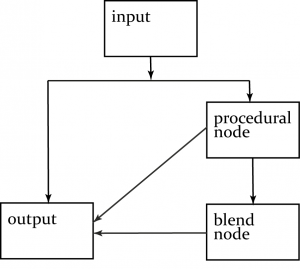Procedural Blending and Annalist
From Graham Klyne
On Friday 9 October, Iris Garrelfs and Graham Klyne attended a “Linked Music Hackathon” at Goldsmith’s University. The event was organised by Kevin Paige and David Weigl under the auspices of the Semantic Media projects SLICKMEM (Semantic Linking and Integration of Content, Knowledge and Metadata in Early Music) and SLoBR (Semantic Linking of BBC Radio). The event brought together those with a shared passion for music and the data that describes it.
We used the meeting to talk about Iris’ Procedural Blending (PB) model, and were able to make good progress on reconciling the model’s goal of providing a framework for discourse about creative processes with more mundane issues of establishing consistency of usage in more formal data descriptions. In the end, we created some separation between purely structural elements of the model, and others that capture aspects of the creative process.
An updated representation of the Procedural Blending model is captured in the Annalist collection describing Iris’ Smoke project and soundtrack. The original notions of “input”, “blend node” and “output” from Iris’ thesis are retained, with the additional concept “procedural node” added [click here for more] to allow mechanical yet vital connecting elements of the process to be represented consistently within the data description.
 A blend node in this system represents a step where key creative decisions are made, where several lines blend into one. By comparison, a procedural node may not embody any actual (creative) decision making. The structural hierarchy is depicted in the diagram to the left.
A blend node in this system represents a step where key creative decisions are made, where several lines blend into one. By comparison, a procedural node may not embody any actual (creative) decision making. The structural hierarchy is depicted in the diagram to the left.
Over the coming weeks, we shall be adding a Procedural Blending description based on these elements to the Annalist data collection describing the creation of the Smoke project. We will also begin to compare the PB model with PROV.

Thanks for this Graham! I just wanted to add that I very much enjoyed the process of clarifying meanings by mapping a creative “workflow” onto data descriptions!